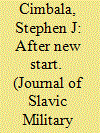|
|
|
Sort Order |
|
|
|
Items / Page
|
|
|
|
|
|
|
| Srl | Item |
| 1 |
ID:
162700


|
|
|
|
|
| Summary/Abstract |
The United States has planned an ambitious strategic nuclear modernization program, as has Russia. Within this context, what are the expectations for New START and its extension to 2026 or beyond? This study analyzes possible scenarios for US strategic nuclear modernization within New START limitations, acknowledging that wild cards include the fate of the INF treaty, threats posed by missile defenses and postmodern counter-defense weapons, and other uncertainties.
|
|
|
|
|
|
|
|
|
|
|
|
|
|
|
|
| 2 |
ID:
162702


|
|
|
|
|
| Summary/Abstract |
The article is concerned with the underground anti-Bolshevik work in the Red Army of assistant commander of the Soviet Southern front, former General A.L. Nosovich, one of the senior Soviet military leaders at the time. The unearthing of a unique personal archive for General Nosovich in France has allowed us to explore this matter in greater depth. The activity of the highly educated and high-ranking White agent former General A.L. Nosovich agent in the Red Army in May–October 1918 is extremely interesting because it allows for reassessment of a number of issues, including the history of the formation of the Red Army, the history of the White underground, the work of the military specialists and the evolution of command cadres within the Red Army, the defense of Tsaritsyn, and the activities of I.V. Stalin at the time.
|
|
|
|
|
|
|
|
|
|
|
|
|
|
|
|
| 3 |
ID:
162701


|
|
|
|
|
| Summary/Abstract |
This article analyzes the emergence of ‘hybrid warfare’, which blurs the line between military and civilian forms of organization, both in the conduct and the target of warfare. The complexity of warfare is increasing due to the growing number and diversity of parties involved. Conflicts no longer remain local; instead, they increasingly attract external actors and extend to the Internet.
In this analysis, the Ukrainian Azov Battalion, which was formed at the beginning of the Ukrainian crisis in 2013, is used as a case study of this new form of ‘hybrid’ war. This analysis considers the history, operations, recruitment, financing, ideology, and tactics of the unit, in light of the available information on the war in Ukraine.
|
|
|
|
|
|
|
|
|
|
|
|
|
|
|
|
| 4 |
ID:
162704


|
|
|
|
|
| Summary/Abstract |
In this article memoir material from Soviet General V. Schur is presented relating to events at Damanskii Island on the Soviet-Chinese border (1969) with commentary. This article also contains additional new information on important details of the Sino-Soviet border conflict at the time.
|
|
|
|
|
|
|
|
|
|
|
|
|
|
|
|
| 5 |
ID:
162703


|
|
|
|
|
| Summary/Abstract |
Motor vehicles have always been regarded as an indicator of modernity, technological advancement, and industrial progress, right from the time of the first motor car in 1885. The Soviet Union was no exception, and there is an extensive Soviet historiography of the development of motor transport and its use during the German-Soviet War. The aim of this article is to put the wartime military and economic use of Soviet vehicles into a wider context, highlighting how mechanization was not the only important variable in successful logistics. The case study here will be the role of transportation in the logistics of a Soviet combined arms army (общевойсковая армия) utilizing detailed primary source material from the pamyat-naroda.ru website.
|
|
|
|
|
|
|
|
|
|
|
|
|
|
|
|
|
|
|
|
|